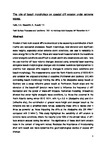The role of beach morphology on coastal cliff erosion under extreme waves
| dc.contributor.author | Earlie, C | |
| dc.contributor.author | Masselink, Gerd | |
| dc.contributor.author | Russell, Paul | |
| dc.date.accessioned | 2018-01-29T11:33:48Z | |
| dc.date.available | 2018-01-29T11:33:48Z | |
| dc.date.issued | 2018-05 | |
| dc.identifier.issn | 0197-9337 | |
| dc.identifier.issn | 1096-9837 | |
| dc.identifier.uri | http://hdl.handle.net/10026.1/10678 | |
| dc.description.abstract |
<jats:title>Abstract</jats:title><jats:p>Erosion of hard‐rock coastal cliffs is understood to be caused by a combination of both marine and sub‐aerial processes. Beach morphology, tidal elevation and significant wave heights, especially under extreme storm conditions, can lead to variability in wave energy flux to the cliff‐toe. Wave and water level measurements in the nearshore under energetic conditions are difficult to obtain and <jats:italic>in situ</jats:italic> observations are rare. Here we use monthly cliff‐face volume changes detected using terrestrial laser scanning alongside beach morphological changes and modelled nearshore hydrodynamics to examine how exposed cliffs respond to changes in extreme wave conditions and beach morphology. The measurements cover the North Atlantic storms of 2013 to 2014 and consider two exposed stretches of coastline (Porthleven and Godrevy, UK) with contrasting beach morphology fronting the cliffs; a flat dissipative sandy beach at Godrevy and a steep reflective gravel beach at Porthleven. Beach slope and the elevation of the beach–cliff junction were found to influence the frequency of cliff inundation and the power of wave–cliff impacts. Numerical modelling (XBeach‐G) showed that under highly energetic wave conditions, i.e. those that occurred in the North Atlantic during winter 2013–2014, with <jats:italic>H</jats:italic><jats:sub>s</jats:sub> = 5.5 m (dissipative site) and 8 m (reflective site), the combination of greater wave height and steeper beach at the reflective site led to amplified wave run‐up, subjecting these cliffs to waves over four times as powerful as those impacting the cliffs at the dissipative site (39 kWm<jats:sup>‐1</jats:sup> compared with 9 kWm<jats:sup>‐1</jats:sup>). This study highlighted the sensitivity of cliff erosion to extreme wave conditions, where the majority (over 90% of the annual value) of cliff‐face erosion ensued during the winter. The significance of these short‐term erosion rates in the context of long‐term retreat illustrates the importance of incorporating short‐term beach and wave dynamics into geomorphological studies of coastal cliff change. © 2017 The Authors. Earth Surface Processes and Landforms published by John Wiley & Sons Ltd.</jats:p> | |
| dc.format.extent | 1213-1228 | |
| dc.language | en | |
| dc.language.iso | en | |
| dc.publisher | Wiley | |
| dc.subject | cliff erosion | |
| dc.subject | terrestrial laser scanning | |
| dc.subject | XBeach-G | |
| dc.subject | beach morphology | |
| dc.subject | extreme waves | |
| dc.title | The role of beach morphology on coastal cliff erosion under extreme waves | |
| dc.type | journal-article | |
| dc.type | Journal Article | |
| plymouth.author-url | https://www.webofscience.com/api/gateway?GWVersion=2&SrcApp=PARTNER_APP&SrcAuth=LinksAMR&KeyUT=WOS:000431493900004&DestLinkType=FullRecord&DestApp=ALL_WOS&UsrCustomerID=11bb513d99f797142bcfeffcc58ea008 | |
| plymouth.issue | 6 | |
| plymouth.volume | 43 | |
| plymouth.publication-status | Published | |
| plymouth.journal | Earth Surface Processes and Landforms | |
| dc.identifier.doi | 10.1002/esp.4308 | |
| plymouth.organisational-group | /Plymouth | |
| plymouth.organisational-group | /Plymouth/Admin Group - REF | |
| plymouth.organisational-group | /Plymouth/Admin Group - REF/REF Admin Group - FoSE | |
| plymouth.organisational-group | /Plymouth/Faculty of Science and Engineering | |
| plymouth.organisational-group | /Plymouth/Faculty of Science and Engineering/School of Biological and Marine Sciences | |
| plymouth.organisational-group | /Plymouth/REF 2021 Researchers by UoA | |
| plymouth.organisational-group | /Plymouth/REF 2021 Researchers by UoA/UoA07 Earth Systems and Environmental Sciences | |
| plymouth.organisational-group | /Plymouth/Research Groups | |
| plymouth.organisational-group | /Plymouth/Research Groups/Marine Institute | |
| plymouth.organisational-group | /Plymouth/Users by role | |
| plymouth.organisational-group | /Plymouth/Users by role/Academics | |
| plymouth.organisational-group | /Plymouth/Users by role/Researchers in ResearchFish submission | |
| dcterms.dateAccepted | 2017-11-28 | |
| dc.rights.embargodate | 2018-12-14 | |
| dc.identifier.eissn | 1096-9837 | |
| dc.rights.embargoperiod | Not known | |
| rioxxterms.versionofrecord | 10.1002/esp.4308 | |
| rioxxterms.licenseref.uri | http://www.rioxx.net/licenses/all-rights-reserved | |
| rioxxterms.type | Journal Article/Review |


